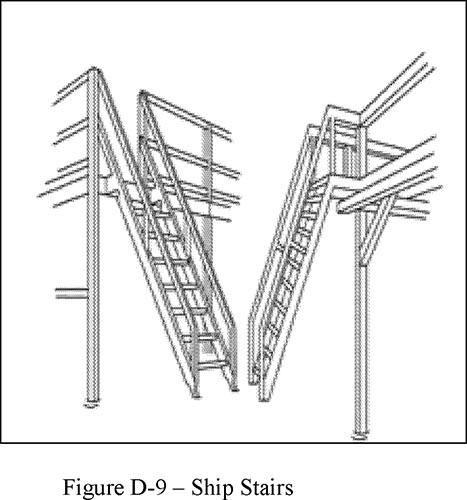- Part Number:1910
- Part Number Title:Occupational Safety and Health Standards
- Subpart:1910 Subpart D
- Subpart Title:Walking-Working Surfaces
- Standard Number:
- Title:Stairways.
- GPO Source:
Application. This section covers all stairways (including standard, spiral, ship, and alternating tread-type stairs), except for articulated stairs (stairs that change pitch due to change in height at the point of attachment) such as those serving floating roof tanks, stairs on scaffolds, stairs designed into machines or equipment, and stairs on self-propelled motorized equipment.
General requirements. The employer must ensure:
When paragraph (b)(8) of this section allows the use of spiral, ship, or alternating tread-type stairs, they are installed, used, and maintained in accordance with manufacturer's instructions.

Standard stairs. In addition to paragraph (b) of this section, the employer must ensure standard stairs:
Have a minimum width of 22 inches (56 cm) between vertical barriers (see Figure D-8 of this section).
Exception to paragraphs (c)(2) and (3) of this section. The requirements of paragraphs (c)(2) and (3) do not apply to standard stairs installed prior to January 17, 2017. OSHA will deem those stairs in compliance if they meet the dimension requirements specified in Table D-1 of this section or they use a combination that achieves the angle requirements of paragraph (c)(1) of this section.
Table D-1 -- Stairway Rise and Tread Dimensions
| Angle to horizontal | Rise (in inches) | Tread run (in inches) |
|---|---|---|
| 30 deg. 35' | 6 ½ | 11 |
| 32 deg. 08' | 6 ¾ | 10 ¾ |
| 33 deg. 41' | 7 | 10 ½ |
| 35 deg. 16' | 7 ¼ | 10 ¼ |
| 36 deg. 52' | 7 ½ | 10 |
| 38 deg. 29' | 7 ¾ | 9 ¾ |
| 40 deg. 08' | 8 | 9 ½ |
| 41 deg. 44' | 8 ¼ | 9 ¼ |
| 43 deg. 22' | 8 ½ | 9 |
| 45 deg. 00' | 8 ¾ | 8 ¾ |
| 46 deg. 38' | 9 | 8 ½ |
| 48 deg. 16' | 9 ¼ | 8 ¼ |
| 49 deg. 54' | 9 ½ | 8 |

Spiral stairs. In addition to paragraph (b) of this section, the employer must ensure spiral stairs:
Ship stairs. In addition to paragraph (b) of this section, the employer must ensure ship stairs (see Figure D-9 of this section):
Have a minimum tread width of 18 inches (46 cm).

Alternating tread-type stairs. In addition to paragraph (b) of this section, the employer must ensure alternating tread-type stairs:
Have a minimum tread width of 7 inches (18 cm), measured at the leading edge of the tread (i.e., nosing).

Figure D-10 -- Angles for Stairs, Ramps, and Ladders. Two figures showing angles for stairs, ramps, and ladders. The first shows from 90 degress to 60 degrees show for ladders. From 70 degrees to 50 degrees show for Alternating Tread-Type Stairs. From 70 degrees to 50 degrees show for Ship Stairs. From 50 degrees to 30 degrees show for Standard Stairs. From 30 degrees to 0 degree show for Ramps. The second is a table showing angle and type. For angles less than or equal to 30 degrees for Ramps. For angles 30 to 50 degrees for Standard Stairs. For angles 50 to 70 degress for Ship Stairs. For angles 50 to 70 degrees for Alternating Tread-Type Stairs. For angles 60 to 90 degrees for Ladders.
[39 FR 23502, June 27, 1974, as amended at 43 FR 49744, Oct. 24, 1978; 49 FR 5321, Feb. 10, 1984; 81 FR 82987-82990, Nov. 18, 2016; 84 FR 68795, Dec. 17, 2019]

